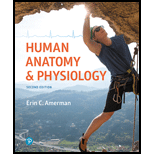
Concept explainers
To review:
Whether the following statements are true or false. False statements are to be corrected:
a. Oxygen is transported primarily by dissolving in the plasma.
b. Each Hb protein can carry up to four oxygen molecules.
c. Hb in arterial blood is normally almost fully saturated.
d. When the
e. Increased
Introduction:
As per Henry’s law, oxygen does not dissolve in great amounts in plasma due to its low solubility in water. Most of the oxygen is transported on hemoglobin. Hemoglobin is a protein that consists of four chains of polypeptides along with a heme group and has one iron ion that binds one molecule of oxygen. Each of these Hb proteins can transport up to four oxygen molecules
Want to see the full answer?
Check out a sample textbook solution
Chapter 21 Solutions
Human Anatomy & Physiology Plus Mastering A&P with Pearson eText -- Access Card Package (2nd Edition) (What's New in Anatomy & Physiology)
- These are NOT part of any graded assignment. Are there other examples of synapomorphy. What is it called when the traits retained are similar to ancestors?arrow_forwardPlease hand draw everying. Thank you! Draw a gram positive bacterial cell below. Your cell should have the following parts, labeled: A coccus shape A capsule The gram positive cell wall should have the peptidoglycan labeled, as well as its component parts (NAM, NAG, and teichoic acid) A cell membrane Fimbriae A nucleoid Ribosomes Inclusionsarrow_forwardDraw a gram negative bacterial cell below. Your cell should have the following parts, labeled: A bacillus shape Fimbriae Amphitrichous flagella 2 membranes (outer and inner) The outer membrane should have lipopolysaccharide (LPS) with lipid A and O antigens Periplasmic space The thin peptidoglycan cell wall between the 2 membranes A nucleoid Ribosomes Inclusionsarrow_forward
- Bacterial species Cell wall type Example: S. mitis Gram positive S. epidermidis H. pylori M. bovis S. marcescens Shape and arrangement Coccus, streptococcus Drawing 0000000arrow_forwardDraw a gram positive bacterial cell below. Your cell should have the following parts, labeled: A coccus shape A capsule The gram positive cell wall should have the peptidoglycan labeled, as well as its component parts (NAM, NAG, and teichoic acid) A cell membrane Fimbriae A nucleoid Ribosomes Inclusionsarrow_forwardwhat rank is above kingdom? order, class, phylum or domainarrow_forward
- in the hierarchy of taconomic categories, with kingdom at the top, what taxon is below classarrow_forwardDo cats fly without wings ?arrow_forwardLuke recently moved to a new apartment and wants to grow houseplants but isn't sure which room will be the best fit for them. Apply your knowledge of the scientific method to recommend a strategy for Luke to follow when determining the ideal location for houseplants in his new apartment.arrow_forward
- A farmer has noticed that his soybean plants produce more beans in some years than others. He claims to always apply the same amount of fertilizer to the plants, but he suspects the difference in crop yield may have something to do with the amount of water the crops receive. The farmer has observed that the soybeans on his farm usually receive between 0 to 0.5 inches of water per day, but he is unsure of the optimal average daily amount of water with which to irrigate. 1. State a question that addresses the farmer’s problem 2. Conduct online research on “soybean crop irrigation" and record a brief summary of the findings 3. Construct a testable hypothesis and record i 4. Design an experiment to test the hypothesis and describe the procedures, variables, and data to be collected 5. What is the purpose of a control group in an experiment? What would the control groups be for each of your designed experiments in this exercise? 6. Describe the data that would be recorded in each of the…arrow_forwardA farmer has noticed that his soybean plants produce more beans in some years than others. He claims to always apply the same amount of fertilizer to the plants, but he suspects the difference in crop yield may have something to do with the amount of water the crops receive. The farmer has observed that the soybeans on his farm usually receive between 0 to 0.5 inches of water per day, but he is unsure of the optimal average daily amount of water with which to irrigate. 1. State a question that addresses the farmer’s problem 2. Conduct online research on “soybean crop irrigation" and record a brief summary of the findings 3. Construct a testable hypothesis and record i 4. Design an experiment to test the hypothesis and describe the procedures, variables, and data to be collectedarrow_forwardA pharmaceutical company has developed a new weight loss drug for adults. Preliminary tests show that the drug seems to be fairly effective in about 75% of test subjects. The drug company thinks that the drug might be most effective in overweight individuals, but they are unsure to whom they should market the product. Use the scientific method to address the pharmaceutical company’s needs: State a research question that addresses the pharmaceutical company's problem Conduct online research on “Body Mass Index” categories and record a brief summary Construct a testable hypothesis and record in Design an experiment to test the hypothesis and describe the procedures, variables, and data to be collected What is the purpose of a control group in an experiment? What would the control groups be for each of your designed experiments in this exercise? Describe the data that would be recorded in each of the experiments you designed. Would it be classified as quantitative or…arrow_forward
 Human Physiology: From Cells to Systems (MindTap ...BiologyISBN:9781285866932Author:Lauralee SherwoodPublisher:Cengage Learning
Human Physiology: From Cells to Systems (MindTap ...BiologyISBN:9781285866932Author:Lauralee SherwoodPublisher:Cengage Learning
 Human Biology (MindTap Course List)BiologyISBN:9781305112100Author:Cecie Starr, Beverly McMillanPublisher:Cengage Learning
Human Biology (MindTap Course List)BiologyISBN:9781305112100Author:Cecie Starr, Beverly McMillanPublisher:Cengage Learning- Basic Clinical Lab Competencies for Respiratory C...NursingISBN:9781285244662Author:WhitePublisher:Cengage





